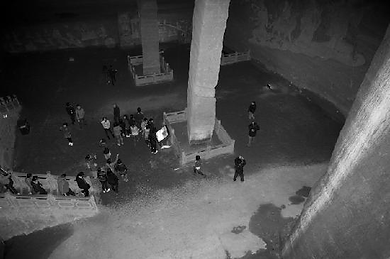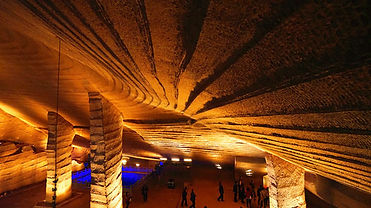

WILL HART

Podcastcast
ALIEN EARTH - ALIEN MIND
Welcome to the New Ancient Enigmas!
The Mystery of the Longyou Caves
There is no shortage of enigmatic archaeological sites in the world. The Great Pyramid in Egypt, Baalbek in Lebanon, Teotihuacan, in Mexico, Puma Punku, in Bolivia…well, the list goes on and on and is really much longer than the average person imagines.
However, most are frozen in gridlock. in terms of historians claiming to know- how and when they were built and by whom. They cannot prove these claims in any scientific manner however. The claims are simply pronounced as being true, more like religious cult members make such claims about their dogmas.
The core belief of academia seems to be that ancient people - using primitive tools and methods - were able to build colossal, even precision-engineered, stone edifices via primitive methods. Again, I say ‘belief’ because this has never been proven by them- not even on a minimal level.
Those in the alternative historical community -- and many intelligent, informed citizens worldwide -- simply do not share this core belief system. In fact, we openly dispute their proposals with rebuttals based upon factual evidence. Because the truth is that these concepts contain very many, serious, even fatal flaws.
Now, happily there are several sites in the world where this situation does not exist. At least not yet. I am going to present them in this chapter. It is refreshing to come across enigmatic, ancient artifacts - that one and all agree - are anomalous, unsolved mysteries to this day.
On the top of my list are the 1) Longyou Caves located in western China, southeast of Shanghai and 2) the Ishi-no-Hoden “Foating Stone” located in Japan on the main island of Honshu x miles from Kyoto.
I) THE LONGYOU CAVES
The story behind the recently discovered Longyou Caves is a fascinating one. I am going to relate, this very engaging backstory below, however, after making a brief but crucial point about extreme disclosure.
Above is an image of the cave before the pond was drained. It was one of dozens of such ponds in this hilly region. The story behind the recently discovered Longyou Caves is a fascinating one. I am going to relate, this very engaging backstory below, however, after making a brief but crucial point about extreme disclosure.
In spite of the fact that the unknown builders excavated and removed about 500,000 tons of waste rock to create the first cave; NO Piles or heaps of the stone (obviously) removed has ever been found!
This is the kind of stark anomaly that historians choose to largely ignore since it does not at all fit into their belief system.
In reality, it is an impossible fact. It simply defies logic and is an anomaly of the first order. It is also an excellent example of what I mean by extreme disclosure.
The lack of there being piles of the waste rock somewhere outside of the cave, 1) cannot be denied and also 2) cannot be explained by conventional historians, period (or anyone else for that matter)
Lastly, this alone. falsifies their working thesis since any early, human culture -- using primitive tools and methods would have had to remove the waste rock manually --- and leave it outside of the cave.
There is simply no refuting that real-world fact either.
In truth, the original, Longyou Cave stands out as an enigma of the first order just on this one piece of its complicated puzzle alone. Now, let us proceed to delve into the details of this fascinating, as yet little-known, ancient archaeological site in the western region of China.
THE LONGYOU CAVE BACKSTORY
The villagers of Shiyan Beicun had fished the many ponds, in the nearby Phoenix Hills for generations. Over the course of many generations, a body of local lore had accumulated about them over the course of the village’s long history.
One legend claimed that some of the ponds were bottomless. Another told of how some were good for fishing but others were not since they did not contain any fish at all. The latter was a source of consternation and dark tales of them being haunted.
In short, these small ponds held an aura of mystery about them for the local people. Several decades ago, a local farmer suddenly grew very curious about the nature of these strange pools of water.
He decided to broach the idea of pumping the water out of one, to finally get at the truth, to some friends. They agreed with him and in 1992 the small group began the pumping operation.
But they were fairly quickly stunned to see artificial structures as the water level dropped. No one in the village had ever mentioned there being anything like this at any of the ponds. Their surprise turned to shock when they drained the water out completely.
Before their disbelieving eyes stood a sophisticated-looking structure that some unknown culture had created. The villagers agreed that none of their folklore mentioned anything about the existence of any of this.
In addition, to their knowledge, nothing was noted about such man- made artifacts in any local or regional history books. However, they decided it would be prudent, to pursue this issue with governmental and academic authorities, to make sure their view was correct.
That process took some time but ended up confirming their initial thoughts. There were not any official records of any kind that described the cave. This is quite strange in China, a country with a very long history, that is normally well-accounted for, documented and meticulously recorded in various texts and annals.
This point was, and still is, taken very seriously by the Chinese government and people. As a result, as the news spread about the Longyou discovery, interest increased steadily. Especially when it was covered in the mass media and people got to see photos of the astonishing cave.
The interior design and craftsmanship are dramatic and striking. Despite the fact that it is simply a space carved out of solid, sandstone bedrock, there is an elegant, almost cathedral-like beauty to it as if it were some kind of shrine.
The initial Longyou Cave discovered, as described above, is a very large, artificial cavern with a specific, pre-planned design. (Below insert)
Now, to backtrack and firmly establish what we are examining here, let us quickly review the facts: The initial Longyou Cave turned out to be a large ‘manmade’ sandstone cavern located at Phoenix Hill, close to the small village of Shiyan Beicun by the Qu River, Lingyou County, in China’s Zhejiang Province.
The local villages had no idea that this cave existed and no mention of it appeared in their local folklore. This is quite odd and not in keeping with typical enigmatic, ancient artifacts in China. Normally, there are at least peripheral references to unusual historic sites and artifacts in one history or another. Not in this case, however.
The first cave turned out to be quite large and exhibited many sophisticated features. As the diagram reveals it has a peculiar, incline configuration below the surface. However, the entrance which was actually a vertical shaft that led to the cave proper, had filled up with water, and that looked like a pond on the surface.
Once drained, the cave was fully revealed and the floor to ceiling height turned out to be about 90’. It had a staircase and irregularly spaced pillars that extended from floor to ceiling. The pillars displayed carvings created by unidentified artisans.
Now, the news of the Longyou Cave discovery travelled fast among the population of China. But not so rapidly in the academic and scientific communities. People were curious when they saw photos and learned that there were no historical records documenting its builders and date of construction.
However, several of its most obvious features did travel through the intellectual grapevine albeit a bit slowly at first 1) the unique, regular grooves evident on the walls and ceiling. 2) the fact that the cave was at least several thousand years old and yet still intact (when even modern artificial caves last less than 300 years on average).
As a result, the scientific community began to make the trek to the cave to study these and other notable features. As this was going on, there were other major developments in the region.
As if to add exclamation points to this mystery…more ponds with similar configurations were drained out and they too revealed nearly identical caves (23 to date).
In spite of the usual, ’let us demystify the Longyou caves strategy that historians soon trotted out following their investigations the finding of 23 similar caves firmly entrenches them in the anomalous category very deeply.
In addition, there are simply too many features that remain unaccounted for and the public is aware of them in brief:
1) no historical records 2) located in a remote, lightly populated rural region. 3) the evenly spaced tool marks do not look handmade. 4) No tools have been found on the sites. 5) The lack of waste rock piles anywhere in the nearby vicinity as noted in the introduction.
In spite of the best efforts of historians, these caves have become a mystery to the people of China and worldwide via the Internet.
However, puzzling over how the unknown builders were able to carve out these gigantic caverns -- leaving such unique, sophisticated tool marks on the walls -- leaves people scratching their heads.
The mysterious tool marks have, in truth, baffled scientists, as well.
But they wonder even more about how the caves have been able to keep their structural integrity for such a long time. This is a more complex issue that falls into the domain of geologists and engineers.
Academia’s modus operandi regarding the above anomalies is to simply imply that some unknown human builders constructed the caves several thousand years ago. They do so without proof, without any explanation of who, how and why?
This is their knee-jerk historical response to anomalies. Is it time now, for the public to seriously challenge it and demand a full accounting? Yes. I say that because we have reached critical mass in terms of being a scientific-technological yet the intellectual standrds of the social sciences have yet to be upgraded.
TIME FOR A NEW PARADIGM
The above is the knee-jerk institutional-historical response to anomalies. Our problem here is also our problem at the Great Pyramid and Baalbek, et al., worldwide. We have stupendous artifacts that could not have been fashioned by primitive tools and methods.
Yet that is exactly what our academic institutions claim is how they were created. The public is required to hold their doubts in abeyance and accept propositions that run counter to both their native gut reactions and reason.
Ironically, the hard facts are obvious to all informed, educated, thinking persons. Therefore, an obvious intellectual and social gridlock situation has developed and is moving toward a full-on confrontation.
Thus far the conflicting paradigms have battled it out largely in the mass media and on the Internet. But one wonders how much longer our institutions can go on failing to acknowledge the stark realities? The lack of there being piles of waste rock at the Longyou caves means something.
Worse yet, how can they continue to air their erroneous, skewed proposals which are still being championed in textbooks, lectures, films and documentaries, as if they represent the one and only objective, scientifically determined truth of ancient history?
Time will tell. At heart the polarization is based upon a psychological paradigm of ancient history.
Academia generally believes that people in the remote past were simple, hunter-gatherers who were technologically primitive, having created stone tools, basic dwellings, and rudimentary social forms.
However, a tacit assumption never articulated, that is nonetheless plugged into that model, is also included: a) only human cultures have ever existed on the earth. b) therefore, only they could have created whatever ancient artifacts are found in the archaeological record.
That is the core of the debate that has been and is going on, which can be largely traced back to Erik von Daniken’s book, Chariots of the Gods?
The problem is that, as noted above, there are anomalous artifacts created during the era when people lacked the knowledge and tools to create them!
THE PURPLE GORILLA IN THE ROOM
It is patently obvious that if you accept the premises that academia is using to filter out anomalous data, you can only reach their final conclusion. No other choice is permitted.
Of course, since primitive humans are the sole candidates and they had no more than rudimentary tools to build the Great Pyramid or Longyou Cave, then they were built with those simple, stone tools and unaided manpower methods. (We have no other options)
But clearly that type of rigged, circular thinking is not scientific.
The correct scientific methodology would not contain only one candidate, that box would actually remain blank. Only the evidence would be evaluated and ranked as to its level of sophistication.
Then the level of tool sophistication, necessary to build it, would be evaluated and determined. That is how actual science would be prosecuted in an upgraded version of the disciplines of the social sciences involved, which really do need to be seriously upgraded, in truth.
We either press for such an upgrade and a total rethinking, of each and every ancient anomaly, or we accept that we have to avoid the purple gorilla jumping up and down in the conference room. (No, he is not really there making all that distracting noise, no…he’s not sticking his big, dirty finger in the punch bowl, NO!)
The fact is that the Longyou Caves were predesigned by architects and built by engineers with high levels of knowledge. And those levels simply cannot be accounted for given the working paradigm. They shouldn’t exist.
The evenly spaced tool marks also should not be there, but are…and the waste rock piles that should be there, but are not. The old, working paradigm has to go, heave ho, overboard!
When we discover the same types of tool marks in caves (that exist in modern caves today) that date back far beyond the time when any formally recorded technology capable of producing them existed, the only other choice is to step back into the age of irrationalism and denial of factual reality.
To truly understand the caves and similar structures, you need to be able to literally “think outside of the box.” That is going to be the main task of future social scientists.
To be one, you must be ready to constantly change your previous notions and reconsider prevailing hypotheses and theories, in the light of new facts and artifacts emerging to the surface every day.
It is, however, understandably difficult for any academic to throw away theories that they spent almost a decade studying; and on which they have based their entire academic careers.
Oh well, in truth very similar things happened throughout history, I think we refer to it as progress…old ways of thinking and doing things give way to new more effective habits of thought and methods.
No one said that progress is a painless, stress-free process!
There are literally dozens and dozens of similar, enigmatic sites and artifacts worldwide that need to be viewed through new minds, new systems of analysis and new paradigms.
Now let’s examine some interesting facts relating to the tool marks in the Longyou Caves.
-
They were carved manually, leaving tool marks.
-
The marks are clearly uniform. They are nearly perfectly aligned to one another, as if they were made by a machine of some type.
-
The tool marks in the Lonyou Caves are nearly identical to those in the Sierra de San Cristóbal cave of Spain. Why?
-
They are spread across the floors, walls, and ceilings of the caverns.
Some of the most intriguing & challenging questions to ponder:
-
How did the caverns manage to hold their integrity for more than 2,000 years?
-
Who created them and is it even possible to answer this question?
-
What type of technology did the unidentified builders use?
-
Why is there no mention of the caves in any historical records?
-
Why did the builders construct so many caves in this particular region and where did they originate and later depart to?
-
How was the waste rock disposed of?
-
?
Asking questions is one part of solving any mystery; the other is being able to accept the answers you get regardless of how they may impact your worldview.
Are we willing to adapt what we believe we know to accommodate what we discover, even if the truth is outside the framework of the theories we use to explain history and human potential?
At this late stage of my career in this field, these are the most compelling issues and questions that we must answer honestly very soon…





